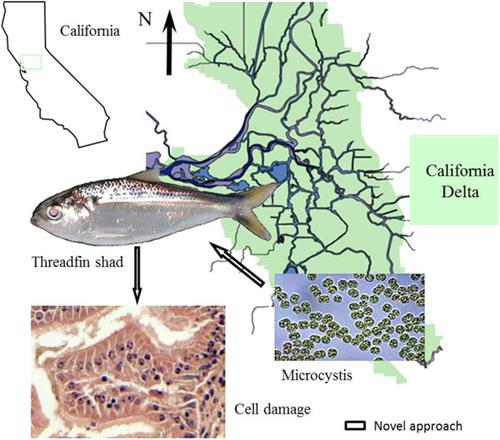当前位置:
X-MOL 学术
›
Environ. Toxicol. Chem.
›
论文详情
Our official English website, www.x-mol.net, welcomes your
feedback! (Note: you will need to create a separate account there.)
Determining the Exposure Pathway and Impacts of Microcystis on Threadfin Shad, Dorosoma petenense, in San Francisco Estuary.
Environmental Toxicology and Chemistry ( IF 3.6 ) Pub Date : 2020-02-21 , DOI: 10.1002/etc.4659 Shawn Acuña 1 , Dolores Baxa 2 , Peggy Lehman 3 , Foo-Ching Teh 2 , Dong-Fang Deng 4 , Swee Teh 2
Environmental Toxicology and Chemistry ( IF 3.6 ) Pub Date : 2020-02-21 , DOI: 10.1002/etc.4659 Shawn Acuña 1 , Dolores Baxa 2 , Peggy Lehman 3 , Foo-Ching Teh 2 , Dong-Fang Deng 4 , Swee Teh 2
Affiliation

|
Blooms of the cyanobacterium Microcystis spp. could affect fish health through the ingestion of colonies as well as exposure to dissolved microcystins in the water column. The goal of the present study was to evaluate the dietary exposure pathway through which Microcystis spp. blooms may affect liver function and nutritional status using a novel approach involving multiple analytical methods to assess the potential risk. Our study was conducted using threadfin shad, Dorosoma petenense, which is a pelagic fish commonly exposed to Microcystis spp. blooms in the upper San Francisco Estuary. The approach incorporated published and optimized methods that offer multiple lines of evidence including in situ hybridization, immunohistochemistry, histopathology, condition factor indices, and nutritional profiles. Measurements of threadfin shad health and tissue condition were conducted at sites where Microcystis was present or absent during the 2007 bloom season. The results showed that dietary exposure to fish from Microcystis blooms resulted in the accumulation of microcystin in the gut and liver tissues of threadfin shad collected from the sites with blooms. Although toxicity endpoints were likely confounded by antecedent conditions, our findings demonstrate dietary exposure of Microcystis toxins to fish using a novel approach with multiple lines of evidence. Environ Toxicol Chem 2020;00:1-12. © 2020 The Authors. Environmental Toxicology and Chemistry published by Wiley Periodicals, Inc. on behalf of SETAC.
中文翻译:

在旧金山河口,确定微囊藻的暴露途径及其对oma鳍,Dorosoma petenense的影响。
蓝藻微囊藻属的花。可能通过摄入菌落以及暴露于水柱中溶解的微囊藻毒素而影响鱼类健康。本研究的目的是评估微囊藻属的饮食接触途径。使用一种包含多种分析方法来评估潜在风险的新颖方法,花朵可能会影响肝功能和营养状况。我们的研究是使用thread鳍,Dorosoma petenense,一种通常暴露于微囊藻属的浮游鱼类。在旧金山河口上游绽放。该方法结合了已发布和优化的方法,可提供多种证据,包括原位杂交,免疫组织化学,组织病理学,条件因子指数和营养状况。在2007年盛开季节中存在或不存在微囊藻的地方进行了thread鳍健康和组织状况的测量。结果表明,饮食中暴露于微囊藻水华的鱼类导致微囊藻毒素在从具有水华藻的场所收集的thread鱼的肠道和肝脏组织中积累。尽管毒性终点可能与先前的条件混淆,但我们的发现表明,采用具有多种证据的新颖方法,饮食中微囊藻毒素在鱼类中的暴露。环境毒性化学2020; 00:1-12。©2020作者。Wiley Periodicals,Inc.代表SETAC出版的《环境毒理学和化学》。结果表明,饮食中暴露于微囊藻水华的鱼类导致微囊藻毒素在从具有水华藻的场所收集的thread鱼的肠道和肝脏组织中积累。尽管毒性终点可能与先前的条件混淆,但我们的发现表明,采用具有多种证据的新颖方法,饮食中微囊藻毒素在鱼类中的暴露。环境毒性化学2020; 00:1-12。©2020作者。Wiley Periodicals,Inc.代表SETAC出版的《环境毒理学和化学》。结果表明,饮食中暴露于微囊藻水华的鱼类导致微囊藻毒素在从具有水华藻的场所收集的thread鱼的肠道和肝脏组织中积累。尽管毒性终点可能与先前的条件混淆,但我们的发现表明,采用具有多种证据的新颖方法,饮食中微囊藻毒素在鱼类中的暴露。环境毒性化学2020; 00:1-12。©2020作者。Wiley Periodicals,Inc.代表SETAC出版的《环境毒理学和化学》。我们的发现表明,采用具有多种证据的新颖方法,饮食中微囊藻毒素暴露于鱼类。环境毒性化学2020; 00:1-12。©2020作者。Wiley Periodicals,Inc.代表SETAC出版的《环境毒理学和化学》。我们的发现表明,采用具有多种证据的新颖方法,饮食中微囊藻毒素暴露于鱼类。环境毒性化学2020; 00:1-12。©2020作者。Wiley Periodicals,Inc.代表SETAC出版的《环境毒理学和化学》。
更新日期:2020-02-21
中文翻译:

在旧金山河口,确定微囊藻的暴露途径及其对oma鳍,Dorosoma petenense的影响。
蓝藻微囊藻属的花。可能通过摄入菌落以及暴露于水柱中溶解的微囊藻毒素而影响鱼类健康。本研究的目的是评估微囊藻属的饮食接触途径。使用一种包含多种分析方法来评估潜在风险的新颖方法,花朵可能会影响肝功能和营养状况。我们的研究是使用thread鳍,Dorosoma petenense,一种通常暴露于微囊藻属的浮游鱼类。在旧金山河口上游绽放。该方法结合了已发布和优化的方法,可提供多种证据,包括原位杂交,免疫组织化学,组织病理学,条件因子指数和营养状况。在2007年盛开季节中存在或不存在微囊藻的地方进行了thread鳍健康和组织状况的测量。结果表明,饮食中暴露于微囊藻水华的鱼类导致微囊藻毒素在从具有水华藻的场所收集的thread鱼的肠道和肝脏组织中积累。尽管毒性终点可能与先前的条件混淆,但我们的发现表明,采用具有多种证据的新颖方法,饮食中微囊藻毒素在鱼类中的暴露。环境毒性化学2020; 00:1-12。©2020作者。Wiley Periodicals,Inc.代表SETAC出版的《环境毒理学和化学》。结果表明,饮食中暴露于微囊藻水华的鱼类导致微囊藻毒素在从具有水华藻的场所收集的thread鱼的肠道和肝脏组织中积累。尽管毒性终点可能与先前的条件混淆,但我们的发现表明,采用具有多种证据的新颖方法,饮食中微囊藻毒素在鱼类中的暴露。环境毒性化学2020; 00:1-12。©2020作者。Wiley Periodicals,Inc.代表SETAC出版的《环境毒理学和化学》。结果表明,饮食中暴露于微囊藻水华的鱼类导致微囊藻毒素在从具有水华藻的场所收集的thread鱼的肠道和肝脏组织中积累。尽管毒性终点可能与先前的条件混淆,但我们的发现表明,采用具有多种证据的新颖方法,饮食中微囊藻毒素在鱼类中的暴露。环境毒性化学2020; 00:1-12。©2020作者。Wiley Periodicals,Inc.代表SETAC出版的《环境毒理学和化学》。我们的发现表明,采用具有多种证据的新颖方法,饮食中微囊藻毒素暴露于鱼类。环境毒性化学2020; 00:1-12。©2020作者。Wiley Periodicals,Inc.代表SETAC出版的《环境毒理学和化学》。我们的发现表明,采用具有多种证据的新颖方法,饮食中微囊藻毒素暴露于鱼类。环境毒性化学2020; 00:1-12。©2020作者。Wiley Periodicals,Inc.代表SETAC出版的《环境毒理学和化学》。











































 京公网安备 11010802027423号
京公网安备 11010802027423号